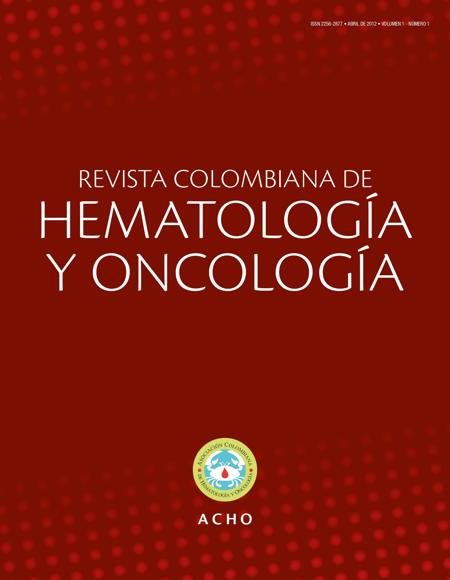Trasplante alogénico de progenitores hematopoyéticos para síndromes de falla medular, experiencia de la Unidad de Trasplante de Médula Ósea de la Clínica de Marly.
Allogenic stem cell transplantation for bone marrow failure syndrome, experience from the Bone Marrow Transplant Unit at the Clínica de Marly.

Esta obra está bajo una licencia internacional Creative Commons Atribución-NoComercial-CompartirIgual 4.0.
Mostrar biografía de los autores
Introducción: El trasplante alogénico de precursores hematopoyéticos (TAPH) es considerado como el tratamiento de elección para los pacientes menores de 40 años con síndromes de falla medular (SFM), así como para los pacientes mayores quienes han fallado al tratamiento inmunosupresor. Métodos: Se realizó un estudio retrospectivo de los pacientes pediátricos y adultos con diagnóstico de SFM sometidos a trasplante alogénico en una única institución de Bogotá (Colombia). El desenlace primario fue la supervivencia global (SG) a cinco años mediante el método de Kaplan-Meier. Se utilizó la prueba log-rank para determinar el efecto de varios factores sobre la SG. Se exploró la estancia hospitalaria, la presentación de enfermedad injerto contra huésped aguda (EICHa) grados II-IV y la falla secundaria del injerto. Resultados: Entre enero de 1993 y agosto de 2011 se realizaron 74 trasplantes en 70 pacientes. En 70 casos los donantes fueron hermanos HLA idénticos, en 3 se obtuvo de la sangre de cordón umbilical y en 1 fue a partir de un hermano haploidéntico. Los condicionamientos más utilizados fueron: Cy-Flu-ATG no mieloablativo (22), Cy-ATG (33) y Cy (12). Cuatro pacientes recibieron condicionamientos con alemtuzumab. Antes del 2004, la mayoría de los pacientes recibió profilaxis para EICH con Cs y MTX; después del 2004, se utilizó Cs y MMF. Dos pacientes murieron el día de la infusión de progenitores hematopoyéticos. Para el primer TAPH, el injerto de neutrófilos para los 68 pacientes se documentó en promedio a los 11.5 días, de manera similar entre los esquemas de acondicionamiento. Diez pacientes (14%) presentaron una falla secundaria del injerto, de quienes 5 murieron en promedio a los 178 días después del TAPH. De los 5 restantes, 2 se encuentran con dependencia transfusional y 3 fueron trasplantados exitosamente por segunda vez. La EICHa G II-IV se presentó en el 30%, del cual el 46.7% murió por complicaciones relacionadas; esta complicación fue más frecuente en los pacientes cuyos regímenes no incorporaban ATG. Para una mediana de seguimiento de 18.4 meses (rango 4.3-45.3), la SG fue del 69.1% y varió de acuerdo con el régimen de acondicionamiento (p = 0.0008). Con el condicionamiento no mieloablativo, se lograron unas estancias hospitalarias más cortas, los pacientes presentaron menos días de fiebre, se requirieron menos transfusiones y menos días de nutrición parenteral. No hubo diferencias significativas relacionadas con la edad (p = 0.67). Se observó una SG mayor pero no significativa en los pacientes tratados después del año 2004 (p = 0.38). Conclusiones: La presente experiencia demostró que el TAPH es una opción terapéutica primordial que ofrece una mejor SG para los pacientes con SFM, independientemente de la edad y el año de la realización, y sugiere una ventaja del condicionamiento no mieloablativo basado en fludarabina.
Visitas del artículo 511 | Visitas PDF 293
- Young NS, Maciejewski J. The pathophysiology of acquired aplastic anemia. N Engl J Med. 1997;336(19):1365-72.
- Marsh JC, Ball SE, Cavenagh J, Darbyshire P, Dokal I, GordonSmith EC, et al. Guidelines for the diagnosis and management of aplastic anaemia. Br J Haematol. 2009;147(1):43-70.
- Sanders JE, Storb R, Anasetti C, Deeg HJ, Doney K, Sullivan KM, et al. Marrow transplant experience for children with severe aplastic anemia. Am J Pediatr Hematol Oncol. 1994;16(1):43-9.
- Medeiros LA, Pasquini R. Anemia aplásica adquirida e anemia de Fanconi: diretrizes brasileiras em transplante de células-tronco hematopoéticas. Rev Bras Hematol Hemoter. 2010;32(supl 1):40-5.
- Deeg HJ, Leisenring W, Storb R, Nims J, Flowers ME, Witherspoon RP, et al. Long-term outcome after marrow transplantation for severe aplastic anemia. Blood. 1998;91(10):3637-45.
- Gluckman E, Socie G, Devergie A, Bourdeau-Esperou H, Traineau R, Cosset JM. Bone marrow transplantation in 107 pa tients with severe aplastic anemia using cyclophosphamide and thoraco-abdominal irradiation for conditioning: long-term follow-up. Blood. 1991;78(9):2451-5.
- Bacigalupo A, Brand R, Oneto R, Bruno B, Socie G, Passweg J, et al. Treatment of acquired severe aplastic anemia: bone marrow transplantation compared with immunosuppressive therapy--The European Group for Blood and Marrow Transplantation experience. Semin Hematol. 2000;37(1):69-80.
- Arranz R, Conde E, Rodriguez-Salvanes F, Pajuelo FJ, Cabrera R, Sanz MA, et al. CsA-based post-graft immunosuppression: the main factor for improving outcome of allografted patients with acquired aplastic anemia. A retrospective survey by the Spanish Group of Hematopoietic Transplantation. Bone Marrow Transplant. 2002;29(3):205-11.
- Ades L, Mary JY, Robin M, Ferry C, Porcher R, Esperou H, et al. Long-term outcome after bone marrow transplantation for severe aplastic anemia. Blood. 2004;103(7):2490-7.
- Kim I, Yoon SS, Park S, Kim BK, Kim NK. The treatment of severe aplastic anemia: outcomes of bone marrow transplantation and immunosuppressive therapy in a single institution of Korea. J Korean Med Sci. 2003;18(3):365-71.
- Storb R, Blume KG, O’Donnell MR, Chauncey T, Forman SJ, Deeg HJ, et al. Cyclophosphamide and antithymocyte globulin to condition patients with aplastic anemia for allogeneic marrow transplantations: the experience in four centers. Biol Blood Marrow Transplant. 2001;7(1):39-44.
- Sangiolo D, Storb R, Deeg HJ, Flowers MED, Martin PJ, Sandmaier BM, et al. Outcome of allogeneic hematopoietic cell transplantation from HLA-identical siblings for severe aplastic anemia in patients over 40 years of age. Biol Blood Marrow Transplant. 2010;16(10):1411-8.
- Maury S, Bacigalupo A, Anderlini P, Aljurf M, Marsh J, Socie G, et al. Improved outcome of patients older than 30 years receiving HLA-identical sibling hematopoietic stem cell transplantation for severe acquired aplastic anemia using fludarabine-based conditioning: a comparison with conventional conditioning regimen. Haematologica. 2009;94(9):1312-5.
- Glucksberg H, Storb R, Fefer A, Buckner CD, Neiman PE, Clift RA, et al. Clinical manifestations of graft-versus-host disease in human recipients of marrow from HL-A-matched sibling donors. Transplantation. 1974;18(4):295-304.
- Champlin RE, Horowitz MM, van Bekkum DW, Camitta BM, Elfenbein GE, Gale RP, et al. Graft failure following bone marrow transplantation for severe aplastic anemia: risk factors and treatment results. Blood. 1989;73(2):606-13.
- Camitta BM, Storb R, Thomas ED. Aplastic anemia (first of two parts): pathogenesis, diagnosis, treatment, and prognosis. N Engl J Med. 1982;306(11):645-52.
- Locasciulli A, Oneto R, Bacigalupo A, Socié G, Korthof E, Bekassy A, et al. Outcome of patients with acquired aplastic anemia given first line bone marrow transplantation or immunosuppressive treatment in the last decade: a report from the European Group for Blood and Marrow Transplantation. Haematologica. 2007;92(1):11-8.
- Barriga CF, Wietstruck PA, Becker KA, Zúñiga CP, de Besa CP, Álvarez ZM, et al. Tratamiento de anemia aplásica severa adquirida en pacientes pediátricos con inmunosupresión y trasplante alogénico de precursores hematopoyéticos. [Treatment of acquired severe aplastic anemia in pediatric patients with immunosupression and allogeneic stem cell hematopoyetic transplant]. Rev Med Chil. 2007;135(11):1421-8.
- Passweg JR, Socie G, Hinterberger W, Bacigalupo A, Biggs JC, Camitta BM, et al. Bone marrow transplantation for severe aplastic anemia: has outcome improved? Blood. 1997;90(2):858-64.
- Chu R, Brazauskas R, Kan F, Bashey A, Bredeson C, Camitta B, et al. Comparison of outcomes after transplantation of GCSF–stimulated bone marrow grafts versus bone marrow or peripheral blood grafts from HLA-matched sibling donors for patients with severe aplastic anemia. Biol Blood Marrow Transplant. 2011;17(7):1018-24.
- Ghavamzadeh A, Alimoghaddam K, Hamidieh AA, Jalili M, Bahar B, Iravani M, et al. Peripheral blood stem cell transplantation versus bone marrow transplantation in severe aplastic anemia. Biol Blood Marrow Transplant. 2011;17(2):S291.
- George B, Mathews V, Viswabandya A, Kavitha ML, Srivastava A, Chandy M. Fludarabine and cyclophosphamide based reduced intensity conditioning (RIC) regimens reduce rejection and improve outcome in Indian patients undergoing allogeneic stem cell transplantation for severe aplastic anemia. Bone Marrow Transplant. 2007;40(1):13-8.
- Storb R, Etzioni R, Anasetti C, Appelbaum F, Buckner CD, Bensinger W, et al. Cyclophosphamide combined with antithymocyte globulin in preparation for allogeneic marrow transplants in patients with aplastic anemia. Blood. 1994;84(3):941-9.
- Champlin RE, Perez WS, Passweg JR, Klein JP, Camitta BM, Gluckman E, et al. Bone marrow transplantation for severe aplastic anemia: a randomized controlled study of conditioning regimens. Blood. 2007;109(10):4582-5.
- Champlin RE, Perez WS, Passweg J, Klein JP, Camitta BM, Gluckman E, et al. Addition of antithymocyte globulin (ATG) to cyclophosphamide (Cy) for HLA-identical sibling allogeneic bone marrow transplantation (BMT) for severe aplastic anemia (SAA): results of a randomized controlled trial. Blood. 2003;102(11):80a.
- Kapelushnik J, Or R, Slavin S, Nagler A. A fludarabine-based protocol for bone marrow transplantation in Fanconi’s anemia. Bone Marrow Transplant. 1997;20(12):1109-10.
- Bacigalupo A, Locatelli F, Lanino E, Marsh J, Socie G, Maury S, et al. Fludarabine, cyclophosphamide and anti-thymocyte globulin for alternative donor transplants in acquired severe aplastic anemia: a report from the EBMT-SAA Working Party. Bone Marrow Transplant. 2005;36(11):947-50.
- Kumar R, Prem S, Mahapatra M, Seth T, Chowdhary DR, Mishra P, et al. Fludarabine, cyclophosphamide and horse antithymocyte globulin conditioning regimen for allogeneic peripheral blood stem cell transplantation performed in non-HEPA filter rooms for multiply transfused patients with severe aplastic anemia. Bone Marrow Transplant. 2006;37(8):745-9.
- Locatelli F, Zecca M, Pession A, Morreale G, Longoni D, Di Bartolomeo P, et al. The outcome of children with Fanconi anemia given hematopoietic stem cell transplantation and the influence of fludarabine in the conditioning regimen: a report from the Italian pediatric group. Haematologica. 2007;92(10):1381-8.
- Ringden O, Remberger M, Svenberg P, Svahn BM, Dahllof G, Gustafsson B, et al. Fludarabine-based disease-specific conditioning or conventional myeloablative conditioning in hematopoietic stem cell transplantation for treatment of non-malignant diseases. Bone Marrow Transplant. 2007;39(7):383-8.
- George B, Mathews V, Viswabandya A, Kavitha ML, Srivastava A, Chandy M. Fludarabine based reduced intensity conditioning regimens in children undergoing allogeneic stem cell transplantation for severe aplastic anemia. Pediatr Transplant. 2008;12(1):14-9.










